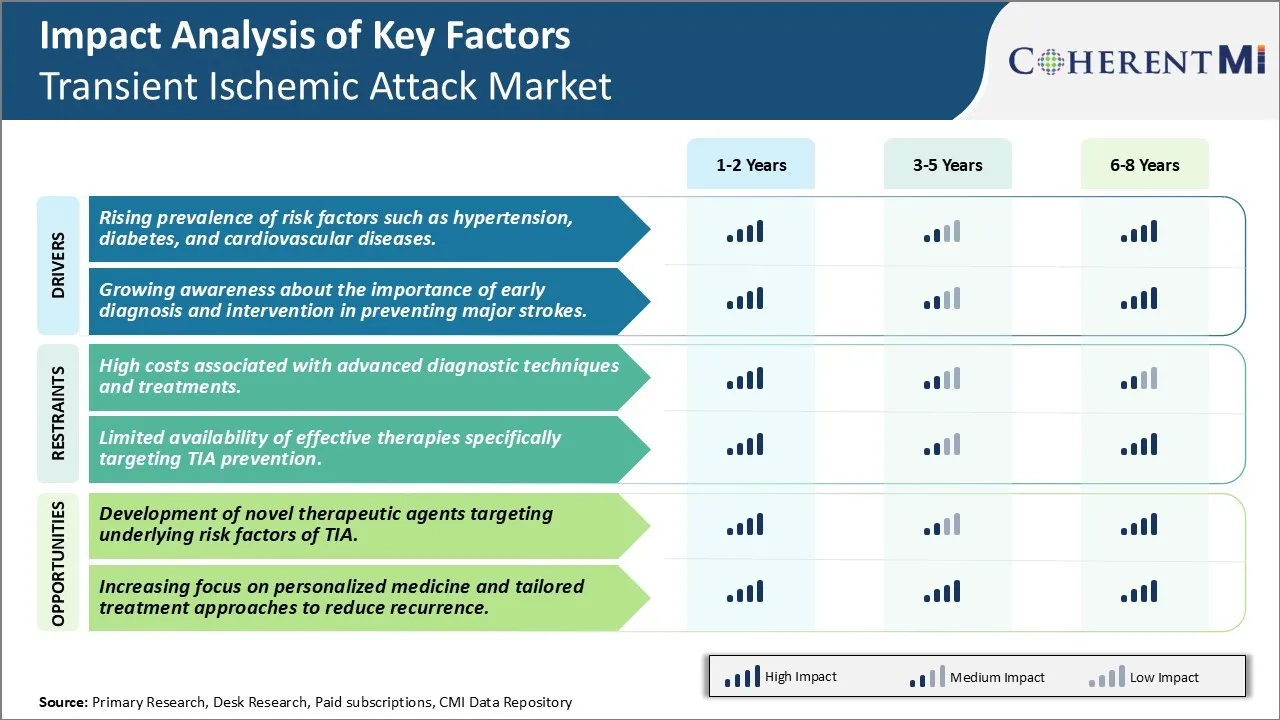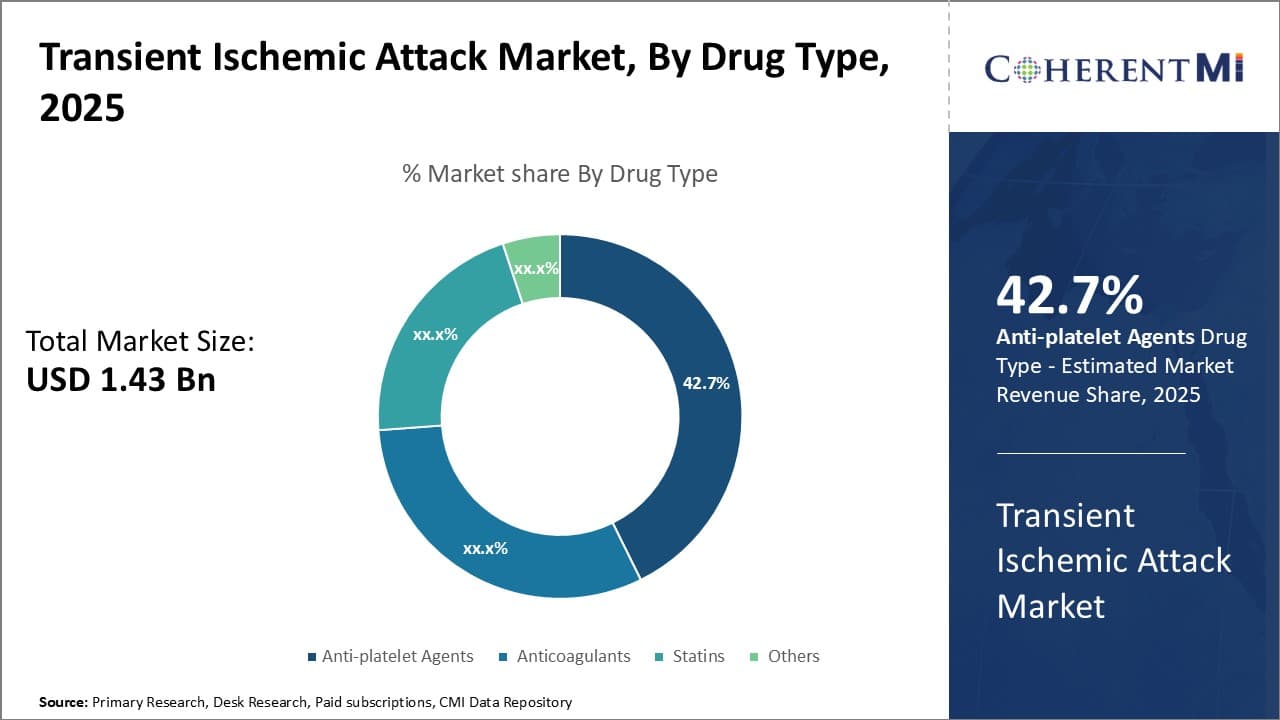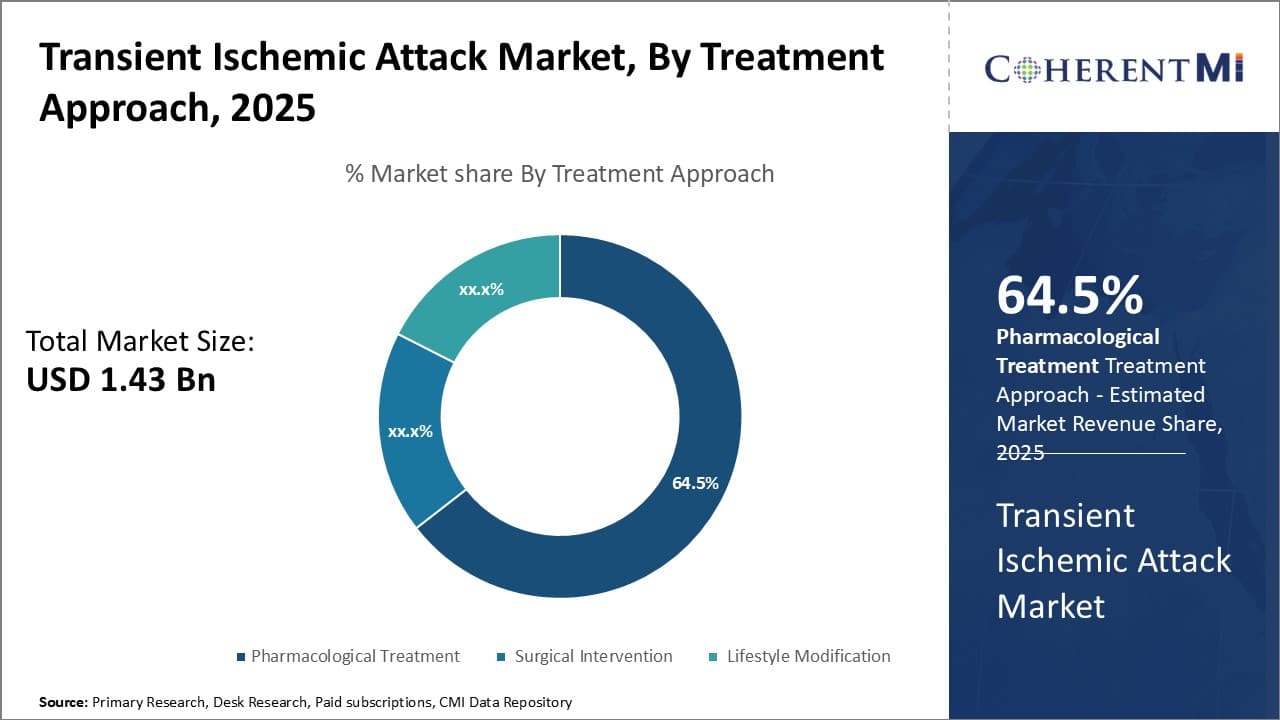Transient Ischemic Attack Market Size - Analysis
The Global Transient Ischemic Attack Market is estimated to be valued at USD 1.43 Bn in 2025 and is expected to reach USD 2.21 Bn by 2032, growing at a compound annual growth rate (CAGR) of 6.4% from 2025 to 2032. The growing geriatric population is one of the key factors driving the market growth, as the risk of TIA increases with age. With an increasing elderly demographic, the market is expected to witness significant demand over the forecast period.
The market is witnessing increasing adoption of novel products for treatment and diagnosis of TIAs. Leading pharmaceutical companies are investing heavily in development of new drug formulations such as antiplatelets and anticoagulants to minimize neurological deficits post TIA. Furthermore, technological advancements in imaging such as CT angiography and MRI have improved diagnosis and management of TIAs. This is expected to support the market growth during the forecast period.
Market Size in USD Bn
CAGR6.4%
| Study Period | 2025-2032 |
| Base Year of Estimation | 2024 |
| CAGR | 6.4% |
| Market Concentration | High |
| Major Players | AstraZeneca, Bristol-Myers Squibb, Janssen LP, Boryung Pharmaceutical Co. Ltd, Orion Pharma and Among Others |
please let us know !
Transient Ischemic Attack Market Trends
Market Driver - Rising Prevalence of Risk Factors Such as Hypertension, Diabetes, and Cardiovascular Disease.
The increasing incidences of conditions like hypertension, diabetes and cardiovascular diseases have been identified as a key factor expected to drive the growth of the transient ischemic attack market. High blood pressure is a major risk factor for TIAs since it damages and weakens blood vessels over time. The rising stress levels, sedentary lifestyles and unhealthy dietary trends have contributed significantly to elevated blood pressure rates globally.
It has been estimated that nearly half of the adult population suffers from hypertension. Conditions like diabetes are also strongly linked to higher chances of TIAs. As more people are diagnosed with diabetes due to the obesity epidemic and increased genetic predispositions, the diabetic population is expanding rapidly. Furthermore, disorders of the cardiovascular system impose mechanical stress on arteries supplying blood to the brain. Diseases affecting the heart and blood vessels such as atrial fibrillation, coronary artery disease further enhance the susceptibility to TIAs.
As the prevalence of these underlying medical ailments increases, so does the risk of occurrences of TIAs within patient groups. Effectively managing diseases like hypertension and diabetes through prescribed regiments remains a challenge with medical non-compliance rates being substantial. This has kept infection rates high in communities.
While advancements in the treatment of cardiovascular illnesses have saved lives, many patients still fall through the cracks due to lack of access to care unless concerted efforts are made towards population-level health improvements and lowering disease burden, occurrences of TIAs are likely to continue trending upwards. This burgeoning patient pool would drive greater demand for diagnostics, monitoring services and post-event rehabilitation therapies. Pharmaceutical companies may also observe growing opportunities in the anti-hypertensive and diabetes drug segments.
Market Driver - Growing Awareness About Early Diagnosis and Intervention
Another key factor supporting the market growth is the enhancement in awareness regarding the importance of timely medical attention after TIA episodes. TIAs were previously underestimated as fairly harmless events that cause fleeting symptoms.
However, it is now well established that they forewarn an impending major stroke if not addressed adequately. Efforts by healthcare providers, support groups and media channels towards disseminating this knowledge have led to increased vigilance among the general public. People who experience warning signs like temporary limb weakness or speech difficulty are more likely to seek emergency medical help instead of neglecting the symptoms.
This has contributed to higher diagnosis rates as more transient attacks are brought to clinical notice. Doctors can then investigate the cause, assess stroke risk level and initiate necessary preventive measures. Community outreach activities stress that getting analyzed promptly after TIAs can help identify risk factors and commence modifications like lifestyle changes, medications before another more damaging clot forms in the brain.
As society comprehends that swift response post-TIA offers the chance to avert long-term disability, they demonstrate greater proclivity towards proactive management options. This trend plays an important role in driving the need for specialized diagnostic brain scans, monitoring services, post-event rehabilitation and recurrence avoidance techniques. Overall, the growing prioritization of prevention over cure works favorable for the expansion of the transient ischemic attack market.
 To learn more about this report,Request Sample Copy
To learn more about this report,Request Sample Copy
Market Challenge: High Costs Associated with Advanced Diagnostic Techniques and Treatments.
One of the major challenges faced in the Transient Ischemic Attack (TIA) market is the high costs associated with advanced diagnostic techniques and treatments. Diagnosing TIA accurately can often require the use of expensive imaging modalities such as MRI and CT scans to rule out other conditions such as strokes. Additionally, in order to manage risk factors and prevent future strokes, patients may require long-term treatment and monitoring which involves multiple physician visits, diagnostic tests and drug therapy.
TIA treatments often involve use of antiplatelet agents and statins which adds to the overall healthcare costs. Moreover, as TIA events often require immediate medical attention, emergency room visits and hospital admissions for observation further drive up the costs of treatment. The financial burden of extensive diagnostic workups and ongoing risk factor management poses significant affordability challenges, especially for patients in lower income groups and without adequate insurance coverage. Addressing the high cost of TIA management is vital to improve patient outcomes, minimize healthcare expenditure and drive further market growth.
Market Opportunity: Development of Novel Therapeutic Agents Targeting Underlying Risk Factors of TIA.
One of the major opportunities in the transient ischemic attack market lies in the development of novel therapeutic agents that can more effectively lower the risk of future ischemic strokes by specifically targeting the underlying causes and risk factors of TIA. Currently available drugs lack selectivity and have certain side effects when used for long term treatments.
There is scope to develop new drug molecules that can selectively modulate pathways responsible for conditions like atherosclerosis, high blood pressure, and hyperlipidemia which predispose patients to TIAs. Drugs minimizing inflammation in blood vessels or targeting mechanisms of plaque rupture in arteries also hold promise. Development of such mechanism-based drugs tailored for TIA indications can help prevent recurrent attacks more efficiently with improved safety profiles. This represents a significant opportunity for pharmaceutical companies to develop advanced treatment options for TIA patients and gain leadership in this clinical area.
Key winning strategies adopted by key players of Transient Ischemic Attack Market
Focus On Innovative Drug Development: AbbVie, Inc. adopted an innovative drug development strategy by investing heavily in R&D. In 2021, they announced positive results from a Phase 3 clinical trial evaluating Ubrelvy (ubrogepant) for the acute treatment of migraine with or without aura in adults.
Ubrelvy achieved all co-primary and secondary endpoints, demonstrating statistically significant pain relief and freedom from most bothersome migraine-associated symptom within two hours. This innovative drug received FDA approval in February 2020 and has been a major commercial success for AbbVie in the migraine treatment market.
Acquisition Strategies: In 2021, Bristol-Myers Squibb acquired MyoKardia for USD 13.1 billion to expand its portfolio in the cardiovascular disease segment. MyoKardia is focused on developing novel medicines for the treatment of serious cardiovascular diseases. Its lead candidate, mavacamten, has the potential to be the first heart failure medicine that uniquely addresses the underlying cause of the disease by improving cardiac muscle function. This major acquisition strengthened BMS's pipeline of potential treatments for heart diseases and transient ischemic attack.
Expand into Emerging Markets: Pfizer has adopted an aggressive strategy to expand its commercial footprint in emerging markets like China, India, Brazil etc. For example, in 2020 it acquired a major stake in Aspen Pharmacare's Chinese operations, strengthening its presence in the fast-growing Chinese pharmaceutical market. Similarly, it has expanded its manufacturing facilities and partnerships in India. This focus on high-growth emerging markets where TIA incidents are rising has boosted Pfizer's revenue from products targeting cerebrovascular diseases.
Segmental Analysis of Transient Ischemic Attack Market
 To learn more about this report,Request Sample Copy
Insights, By Drug Type, Accessibility and Effectiveness drive Anti-platelet Agents' market share.
To learn more about this report,Request Sample Copy
Insights, By Drug Type, Accessibility and Effectiveness drive Anti-platelet Agents' market share.
By Drug Type, Anti-platelet Agents contributes the highest share 42.70% in 2025 owing to its accessibility and effectiveness in treating transient ischemic attack. Anti-platelet agents work by inhibiting platelet activation and aggregation, thereby preventing the formation of blood clots.
Being readily available over-the-counter, they offer easy access as initial treatment option for patients experiencing TIA symptoms. Additionally, antiplatelet drugs like aspirin are a low-cost choice and have demonstrated effectiveness in reducing the risk of future stroke when taken regularly after TIA diagnosis. Their ability to be conveniently obtained without prescription and provide significant clinical benefits contributes greatly to anti-platelet agents' widespread usage and dominance in the TIA drug type segment.
 To learn more about this report,Request Sample Copy
To learn more about this report,Request Sample Copy
Insights, By Treatment Approach, Comprehensiveness drives Pharmacological Treatment's Market Share.
By Treatment Approach, Pharmacological Treatment contributes the highest share 64.50% in 2025 owing to its comprehensiveness in dealing with TIA. Pharmacological treatment involves administering medication regiments that not only help relieve symptoms during TIA episodes but also lower the risk of future cardiovascular events like stroke.
Drugs prescribed under pharmacological treatment cover multiple pathologies like platelet aggregation, blood pressure, and cholesterol levels associated with TIA, making it a holistic form of care. Compared to alternatives like surgical intervention or lifestyle modification alone, pharmacological treatment offers a well-rounded approach that addresses both acute needs and long-term health management of TIA patients. Its ability to comprehensively manage all medical aspects of TIA through medication results in pharmacological treatment being the preferred and largest segment in the treatment approach category.
Insights, By Route of Administration, Simplicity drives Oral Administration's Market Share.
In terms of By Route of Administration, oral contributes the highest share of the market owing to its simplicity. The oral route allows for medication to be administered directly through the mouth in the form of tablets or capsules. Being a non-invasive mode, it does not require insertion of tubes or needles like intravenous or subcutaneous methods.
The oral method is also easier for patients to self-administer and does not need specialized medical supervision. This simplicity of oral drugs makes them very convenient for long-term use to reduce future risks after TIA. Additionally, orally administered formulations also offer portability and discretion which promote higher compliance. Collectively, the user-friendly nature and simplicity of oral administration versus alternatives like intravenous or subcutaneous procedures has enabled it to dominate the route of administration segment.
Additional Insights of Transient Ischemic Attack Market
The Transient Ischemic Attack (TIA) market is poised for substantial growth as awareness about early stroke prevention increases and therapeutic options continue to advance. TIAs, though brief, are crucial indicators of cerebrovascular health, acting as precursors to more severe and potentially debilitating strokes. The market landscape is characterized by the dominance of antiplatelet and anticoagulant therapies, which form the cornerstone of preventive treatment.
However, the field is witnessing rapid innovation with the emergence of novel agents targeting specific pathways involved in TIA. Clinical trials are actively exploring new combinations of drugs, surgical interventions, and lifestyle modifications aimed at reducing recurrence rates and improving patient outcomes. As the prevalence of lifestyle-related risk factors rises globally, the demand for effective TIA management strategies is expected to grow, driving further research and development efforts. The market is marked by collaborations and strategic partnerships among leading pharmaceutical companies to expand their product pipelines and improve access to advanced care.
Competitive overview of Transient Ischemic Attack Market
The major players operating in the transient ischemic attack market include AstraZeneca, Bristol-Myers Squibb, Janssen LP, Boryung Pharmaceutical Co. Ltd, Orion Pharma, Bayer, Alexion, Boston Scientific Corporation, Pfizer, Merck Sharp & Dohme LLC, Eli Lilly and Company, Sanofi, GlaxoSmithKline, Regeneron Pharmaceuticals, Cierra, Acotec Scientific Co., Ltd, Diadexus Inc, Cambridge Theranostics Ltd, Ischemia Care LLC and QuantalX Neuroscience.
Transient Ischemic Attack Market Leaders
- AstraZeneca
- Bristol-Myers Squibb
- Janssen LP
- Boryung Pharmaceutical Co. Ltd
- Orion Pharma
Transient Ischemic Attack Market - Competitive Rivalry
Transient Ischemic Attack Market
(Dominated by major players)
(Highly competitive with lots of players.)
Recent Developments in Transient Ischemic Attack Market
In 2023, Bristol Myers Squibb and Janssen Pharmaceuticals received Fast Track Designation from the U.S. FDA for milvexian, an investigational oral Factor XIa (FXIa) inhibitor. This program is one of the most comprehensive FXIa clinical trials, involving approximately 50,000 patients, focusing on stroke prevention and reducing thrombotic events without increasing bleeding risks. Additionally, Bayer's investigational drug asundexian received Fast Track Designation for stroke prevention in atrial fibrillation patients.
Transient Ischemic Attack Market Segmentation
- By Drug Type
- Anti-platelet Agents
- Anticoagulants
- Statins
- Others
- By Treatment Approach
- Pharmacological Treatment
- Surgical Intervention
- Lifestyle Modification
- By Route of Administration
- Oral
- Intravenous
- Subcutaneous

Would you like to explore the option of buying individual sections of this report?
Ghanshyam Shrivastava - With over 20 years of experience in the management consulting and research, Ghanshyam Shrivastava serves as a Principal Consultant, bringing extensive expertise in biologics and biosimilars. His primary expertise lies in areas such as market entry and expansion strategy, competitive intelligence, and strategic transformation across diversified portfolio of various drugs used for different therapeutic category and APIs. He excels at identifying key challenges faced by clients and providing robust solutions to enhance their strategic decision-making capabilities. His comprehensive understanding of the market ensures valuable contributions to research reports and business decisions.
Ghanshyam is a sought-after speaker at industry conferences and contributes to various publications on pharma industry.
Frequently Asked Questions :
How Big is the Transient Ischemic Attack Market?
The Global Transient Ischemic Attack Market is estimated to be valued at USD 1.43 Bn in 2025 and is expected to reach USD 2.21 Bn by 2032.
What will be the CAGR of the Transient Ischemic Attack Market?
The CAGR of the Transient Ischemic Attack Market is projected to be 6.2% from 2024-2031.
What are the major factors driving the Transient Ischemic Attack Market growth?
The rising prevalence of risk factors such as hypertension, diabetes, and cardiovascular diseases and growing awareness about the importance of early diagnosis and intervention in preventing major strokes are the major factor driving the Transient Ischemic Attack Market.
What are the key factors hampering the growth of the Transient Ischemic Attack Market?
The high costs associated with advanced diagnostic techniques and treatments and limited availability of effective therapies specifically targeting TIA prevention are the major factor hampering the growth of the Transient Ischemic Attack Market.
Which is the leading Drug Type in the Transient Ischemic Attack Market?
Anti-platelet Agents is the leading drug type.
Which are the major players operating in the Transient Ischemic Attack Market?
AstraZeneca, Bristol-Myers Squibb, Janssen LP, Boryung Pharmaceutical Co. Ltd, Orion Pharma, Bayer, Alexion, Boston Scientific Corporation, Pfizer, Merck Sharp & Dohme LLC, Eli Lilly and Company, Sanofi, GlaxoSmithKline, Regeneron Pharmaceuticals, Cierra, Acotec Scientific Co., Ltd, Diadexus Inc, Cambridge Theranostics Ltd, Ischemia Care LLC, QuantalX Neuroscience are the major players.